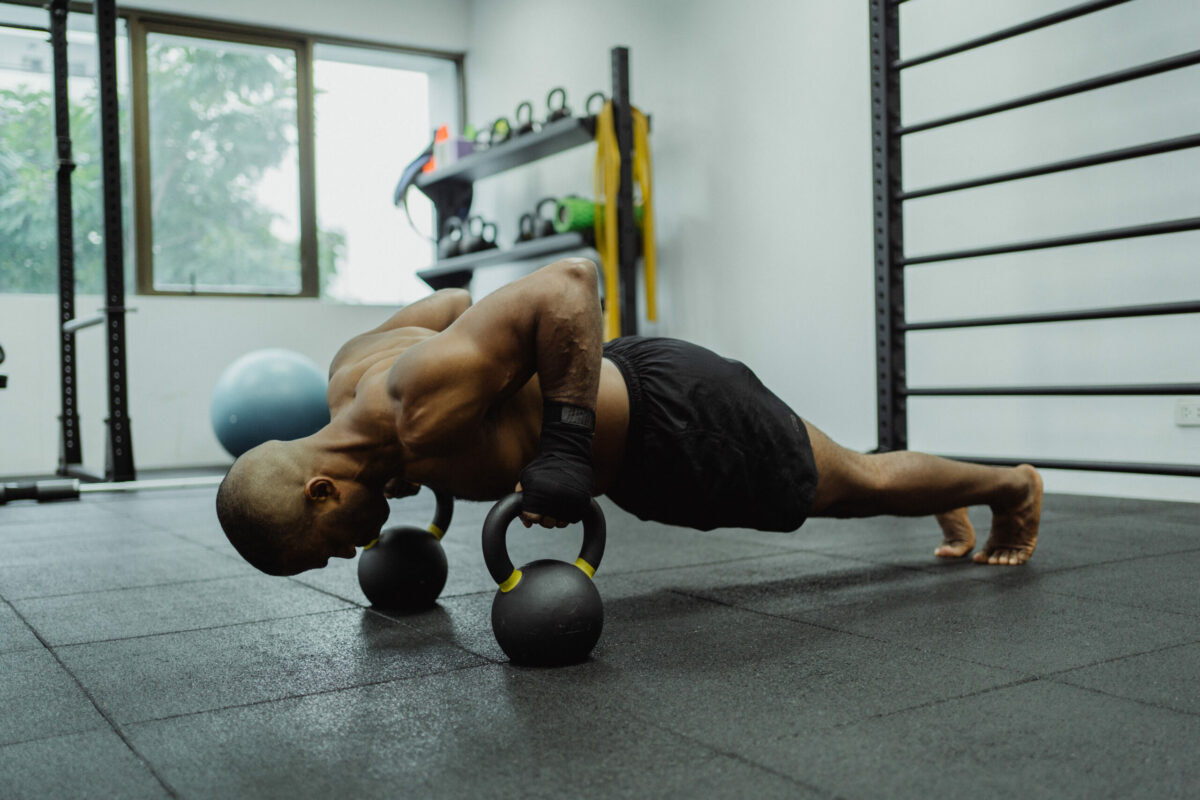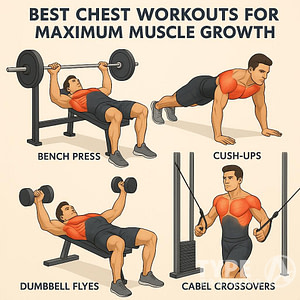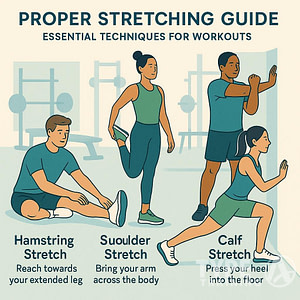Mastering the proper push-up form is a game-changer for your workout routine. Often underestimated, push-ups are a composite exercise that challenges multiple muscle groups and can enhance your overall strength when performed correctly. To get the most from this traditional move, it’s essential to pay close attention to your body alignment and position, ensuring that each rep counts towards your fitness goals without risking injury.
Building a strong foundation in push-up technique lays the groundwork for progressing into more challenging variations. Whether you’re just getting started or looking to refine your form, incorporating specific exercises can significantly improve your push-up strength and endurance. Moreover, these exercises can be tailored to meet your unique fitness objectives, making push-ups a versatile addition to any workout plan.
Key Takeaways
- Proper push-up form requires attention to body alignment to maximize effectiveness and prevent injury.
- Developing strength and endurance through push-ups can be achieved with progressive training and variations.
- A tailored push-up routine can be a cornerstone of achieving specific fitness goals.
Getting Started with Push-Ups
Popular posts:
Before diving into your first push-up, it’s essential to understand the mechanics and positioning that lead to effective and safe execution. An emphasis on proper push-up form will not only help in building upper body and core strength but also minimize the risk of injury.
Understanding Basic Push-Up Mechanics
Push-Ups are a compound exercise that engage multiple muscle groups including the chest, shoulders, triceps, and core. The movement begins in a high plank position with your hands placed slightly wider than shoulder-width apart. As you lower yourself to the ground, aim to keep your body in a straight line, engaging your core to prevent your hips from sagging or hiking up. Efficient push-up mechanics require movement at the shoulder and elbow joints, with elbows bending to a 45-degree angle—close to the body—ensuring a full range of motion.
Fundamentals of Proper Push-Up Position
Your hand position should be firm on the ground, with fingers splayed wide for stability. Align your hands so that when lowering down, your elbows remain directly above your wrists. You should start in a high plank position, with shoulders stacked over your wrists, feet together, and your body forming a straight line from head to heels. It is crucial to activate your core throughout the push-up to maintain this plank position and protect your lower back.
- Plank Position Checklist:
- Hands shoulder-width apart.
- Elbows straight but not locked.
- Body in a straight line.
- Toes grounded, feet together.
Common Push-Up Mistakes to Avoid
Avoiding common mistakes is key to maximizing the benefits of push-ups and reducing injury risk. Common issues include letting the hips sag or pike up, flaring elbows out too wide, and not engaging the core. Another frequent error is not achieving the full range of motion, either by not going low enough or not fully extending the arms. Pay attention to your elbow position; they should not be at 90 degrees to the body, but rather tucked closer to your sides. Correct hand placement is essential; your hands should not be too far forward, past your shoulder line, or too close together.
- Common Mistakes:
- Hips sagging or piking.
- Elbows flaring too wide.
- Lack of core engagement.
- Incomplete range of motion.
Body Alignment and Position
Image Credit: NASM.org
To execute a proper push-up, your form is crucial. Pay close attention to your body’s alignment and the individual positioning of your hands and elbows, as well as core engagement, to ensure a strong foundation and prevent injury.
Optimal Hand Placement and Elbow Alignment
Your hands should be placed on the ground directly under your shoulders or slightly wider. This proper hand placement helps distribute your weight evenly and aligns joints accordingly. Your elbows should remain close to your body, forming a 45-degree angle to minimize strain on the joints and maximize engagement of the chest muscles.
Elbow Position: Keep elbows tucked in, not flared out.
- Aligns the shoulder joint
- Engages the correct muscle groups
Core Activation for Stability
Actively engage your core muscles throughout the exercise to maintain a plank position, keeping the body in a straight line from head to heels. A strong core ensures stability, balance, and protects your lower back while performing a push-up.
Core Strength:
- Focus on tightening your abdominal muscles
- Maintain alignment to prevent sagging or piking of the hips
By concentrating on these aspects of hand placement, elbow alignment, and core activation, you can achieve proper push-up form and lay the foundation for a safe and effective upper-body workout.
Essential Push-Up Variations
Incorporating various push-up exercises into your workout routine can significantly enhance your strength and form. By understanding how to modify push-ups, you can tailor your workout to match your fitness level, whether you’re a beginner or advanced.
From Beginner to Advanced
Beginner: Start with wall push-ups to build foundational strength before progressing to knee push-ups. This regression allows you to focus on form and gradually increase difficulty.
- Wall Push-Ups: Stand facing a wall, place hands on the wall at chest level, and push.
- Knee Push-Ups: On all fours, with knees on the ground, lower your chest to the floor and push up.
Intermediate: Move on to incline push-ups, which can be accomplished using a sturdy bench or step to elevate your hands. This variation still reduces strain but starts to introduce more bodyweight resistance.
- Incline Push-Ups: Place your hands on an elevated platform and perform a push-up.
Advanced: After mastering the incline push-up, you should try decline push-ups to add intensity and focus on the upper chest and handstand push-ups to really challenge your strength and balance.
- Decline Push-Ups: Elevate your feet using a bench or box and perform a standard push-up.
- Handstand Push-Ups: Kick up into a handstand against a wall for support, and bend your elbow to lower your head towards the floor, then push back up.
Exercises to Enhance Push-Up Performance
In addition to push-up variations, supplement your routine with planks to strengthen your core, bench press to build chest and tricep strength, and other strength training exercises to enhance overall performance.
Core:
- Planks: Assume a push-up position but hold it, keeping your body straight and engaging your core.
Chest and Triceps:
- Bench Press: Lie on a bench, lower a barbell to chest level, and press it upwards, targeting the same muscles used in push-ups.
Glutes and Upper Back:
- Incorporate exercises like deadlifts and rows to strengthen your glutes and upper back, providing stability during push-ups.
By integrating these exercises, you can build a solid foundation that will allow you to perform push-ups with better form and less risk of injury. Remember, modifying a push-up to match your skill level is not only acceptable but encouraged to ensure continuous progression and safety in your strength training journey.
Building Your Push-Up Workout Plan
To effectively increase your upper body strength and endurance, a well-structured plan that incorporates push-ups into your routine is vital. By patiently and consistently following this plan, you can maximize the benefits of this fundamental bodyweight exercise.
Incorporating Push-Ups into Your Routine
Begin your workout routine with push-ups to prioritize them when your energy levels are highest.
- Frequency: Aim for 3-4 days per week, allowing your muscles to rest and recover on alternate days.
- Reps and Sets: Start with what you can manage, even if it’s just a few push-ups. Your goal should be to complete 3-4 sets of push-ups, with about 8-10 reps in each set. If you can do more, increase the number gradually or add more sets.
Remember, quality trumps quantity. It’s better to perform a smaller number of push-ups with correct form than to rush through a larger number with poor form. For information on avoiding common mistakes, you can improve your technique with the guidance found in The Perfect Push-Up Form To Build Muscle.
When progressing, consider the following structured approach:
- Weeks 1-2: Focus on mastering the basic push-up form. Use modifications like knee or inclined push-ups if you’re just starting out.
- Weeks 3-4: Work on increasing the number of reps per set or the total number of sets.
- Week 5 onwards: Begin to introduce variations such as wide-grip, diamond, or decline push-ups to challenge different muscle groups and further enhance your upper body strength.
Track your workouts, noting the number of reps, sets, and any variations used. This training log will help you see your progress over time and inform decisions on when to increase intensity or volume. Your commitment to this workout routine will bring clarity to your fitness journey and tangible improvements in your push-up performance.
Improving Push-Up Strength and Endurance
To master push-ups, focusing on both strength and endurance is key. You’ll aim to enhance these two pillars through consistent practice and progression in your training regimen.
Progressive Overload and Repetition
Progressive Overload: To build strength, implementing progressive overload in your push-up routine is essential. This means gradually increasing the difficulty of your push-ups over time. You could:
- Increase Reps: Start with a number of push-ups that you can perform with perfect form; aim to add more reps each week.
- Add Variations: Incorporate advanced push-up variations like spiderman push-ups to challenge your muscles in new ways.
- Use Weights: For an additional challenge, try wearing a weighted vest while performing push-ups.
Endurance Training: Boosting your push-up endurance requires consistent repetition. Begin with multiple sets of lower reps and increase volume over time, always ensuring you maintain perfect form.
Techniques for Push-Up Progression
Mastering Basic Form: Before advancing, ensure your basic push-up form is solid. Your body should form a straight line from your shoulders to your ankles, and your elbows should have a slight bend when at the top of the push-up.
Training for Progression:
- Wall or Incline Push-Ups: If you’re new to push-ups or working on form, start with elevated push-ups to build strength with reduced load.
- Strength Training for Supporting Muscles: Complement your push-up practice with strength training for your chest, shoulders, triceps, and core.
- Push-Up Challenge: Engage in a push-up challenge, progressively increasing the number and difficulty of push-ups each day to build both strength and endurance.
By focusing on these techniques, you’ll be on your way to performing push-ups with increased strength and endurance.
Push-Up Form for Specific Fitness Goals
Optimize your push-up form to meet your specific fitness goals, focusing on technique and training variables that target your desired outcomes.
Push-Ups for Muscle Building
When your aim is to build muscle in your chest, shoulders, and arms—areas pivotal during a push-up—it’s crucial that you emphasize controlled movements and proper form. Elbow positioning is a key aspect; placing your hands so that your elbows create a 45-degree angle with your body can help activate your pecs more effectively and reduce the risk of injury.
- Pecs (Chest Muscles): Ensure your hands are positioned slightly wider than shoulder-width apart to effectively target the chest.
- Shoulders: Keep your shoulders retracted and protracted smoothly with each rep to engage the deltoids without straining them.
- Arms: Full extension and contraction at the elbows will recruit your tricep muscles for a balanced upper body workout.
For hypertrophy, incorporate rep schemes in your workout that induce muscle fatigue, typically within the 8-12 rep range. Ensure you’re progressing by either adding more reps or increasing resistance over time, which could include elevating your feet or wearing a weighted vest. This progression should be a staple in your strength training routine if muscle building is your goal. Remember, maintaining a tight core throughout the movement will stabilize your body and prevent lower back strain.
Supplementary Exercises for Push-Up Mastery
Image Credit: nestacertified.com
To master push-ups, you should focus on developing strength in key muscle groups that contribute to the movement. Targeted exercises will enhance your arm, chest, and core strength, leading to better stability and balance in your push-ups.
Strengthening the Supporting Muscles
- Arms and Triceps: To build arm strength, especially in your triceps which are crucial for push-ups, consider exercises like tricep dips and close-grip bench presses. These exercises will improve your ability to press and stabilize during the push-up motion.
- Chest: For chest strength, incorporate bench presses and dumbbell chest flies. These exercises target your pectoral muscles, which are essential for the downward pushing phase of a push-up.
- Core Strength: A strong core is the foundation for a solid push-up. Engage your core muscles with planks and Russian twists. These exercises help to maintain a rigid torso, which is vital for proper push-up form.
- Shoulder Stability: Shoulder muscles are key to stabilizing your push-up. Strengthen them with shoulder presses and lateral raises. Consistent training will support the shoulder stability needed for push-ups.
- Upper Back: The muscles in your upper back, including your lats and traps, support your bodyweight during a push-up. Strengthen these areas with renegade rows and lat pull-downs to improve your push-up posture and power.
Combining these exercises with your regular push-up training can lead to significant improvements in overall upper body strength and push-up technique. Remember, for the best results, maintain proper form and progressively increase the difficulty of these supplementary exercises as your strength develops.
Frequently Asked Questions
Push-ups are a versatile exercise, ideal for building upper body strength. Here, we address some common queries to help you perfect your technique and explore variations.
What are some variations of push-ups that can enhance different muscle groups?
Incorporating push-up variations like decline push-ups for your upper chest and shoulder muscles or diamond push-ups to target your triceps can add diversity and challenge to your workout. These different push-up variations activate specific muscle groups more intensely.
How can one correctly use push-up bars or push-up boards during their workout?
Push-up bars or boards can help deepen your push-up range of motion while reducing wrist strain. Ensure your wrists, elbows, and shoulders are aligned, and maintain a straight body line from head to heels during the movement. This tool can also introduce more push-up variations to your routine.
What are the key techniques to ensure proper form while performing a push-up?
Proper push-up form involves hands slightly wider than shoulder-width apart, a tight core, and a neutral neck position. Lower your body until your elbows reach 90 degrees while keeping your body straight. Maintaining this form throughout the push-up is crucial for maximizing benefits.
Can you provide a beginner-friendly guide to performing push-ups effectively at home?
Begin with simpler exercises, such as wall push-ups or knee push-ups, and focus on form before progressing to full push-ups. Start with a manageable number of repetitions and gradually increase as you gain strength. Consistent practice at home will improve your ability to perform standard push-ups.
How can beginners, especially women, safely progress to performing standard push-ups?
Women can start with modifications like knee push-ups or incline push-ups and gradually work toward standard push-ups by increasing the difficulty over time. Strengthening core and arm muscles through auxiliary exercises will also aid in this progression.
What exercises can help someone increase their push-up reps and overall upper body strength?
Incorporate exercises such as planks for core stability, bench presses for chest strength, and bent-over rows to engage the upper back. These supplemental exercises improve the muscular endurance necessary to increase push-up reps and enhance upper body strength.












